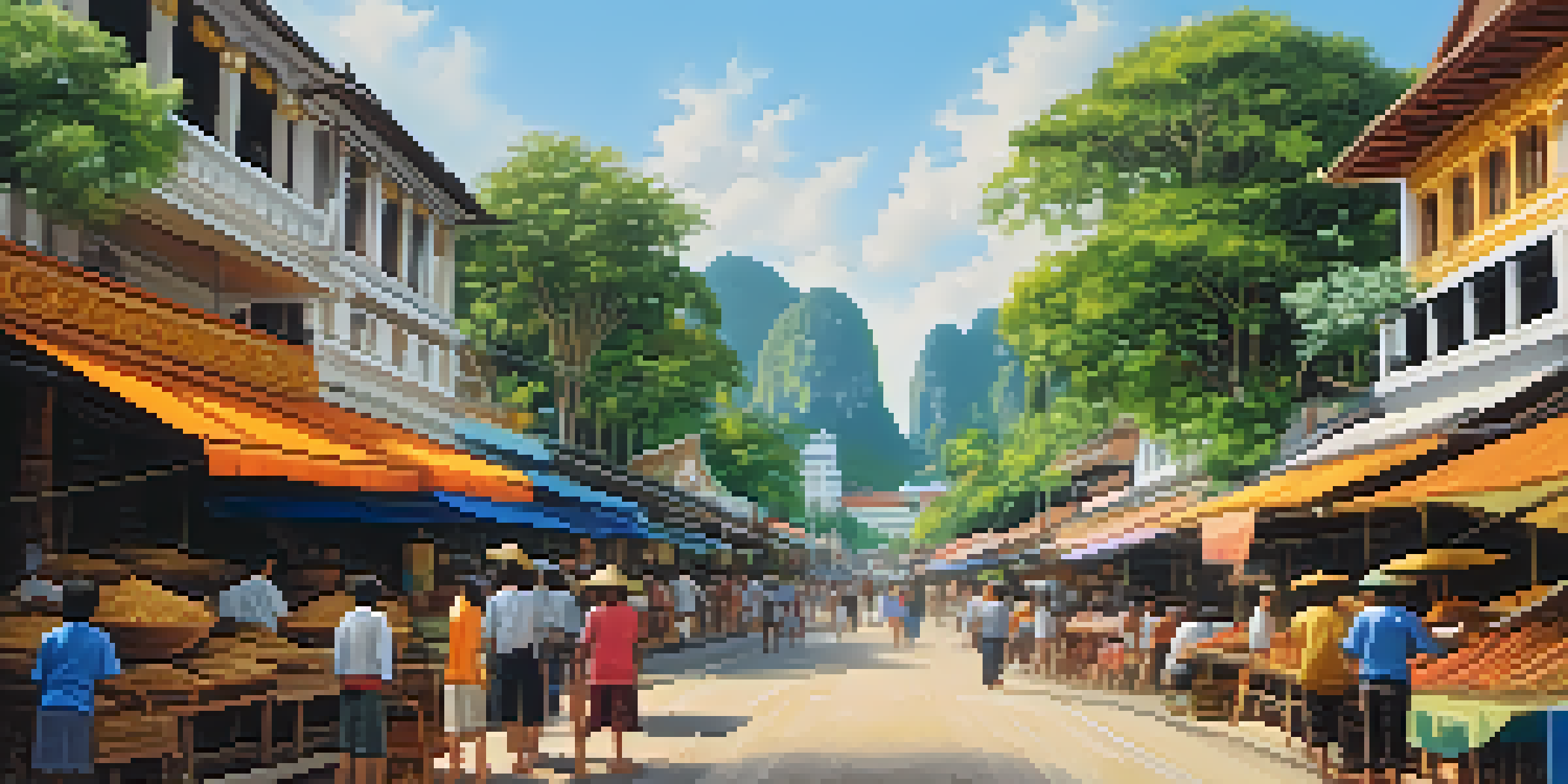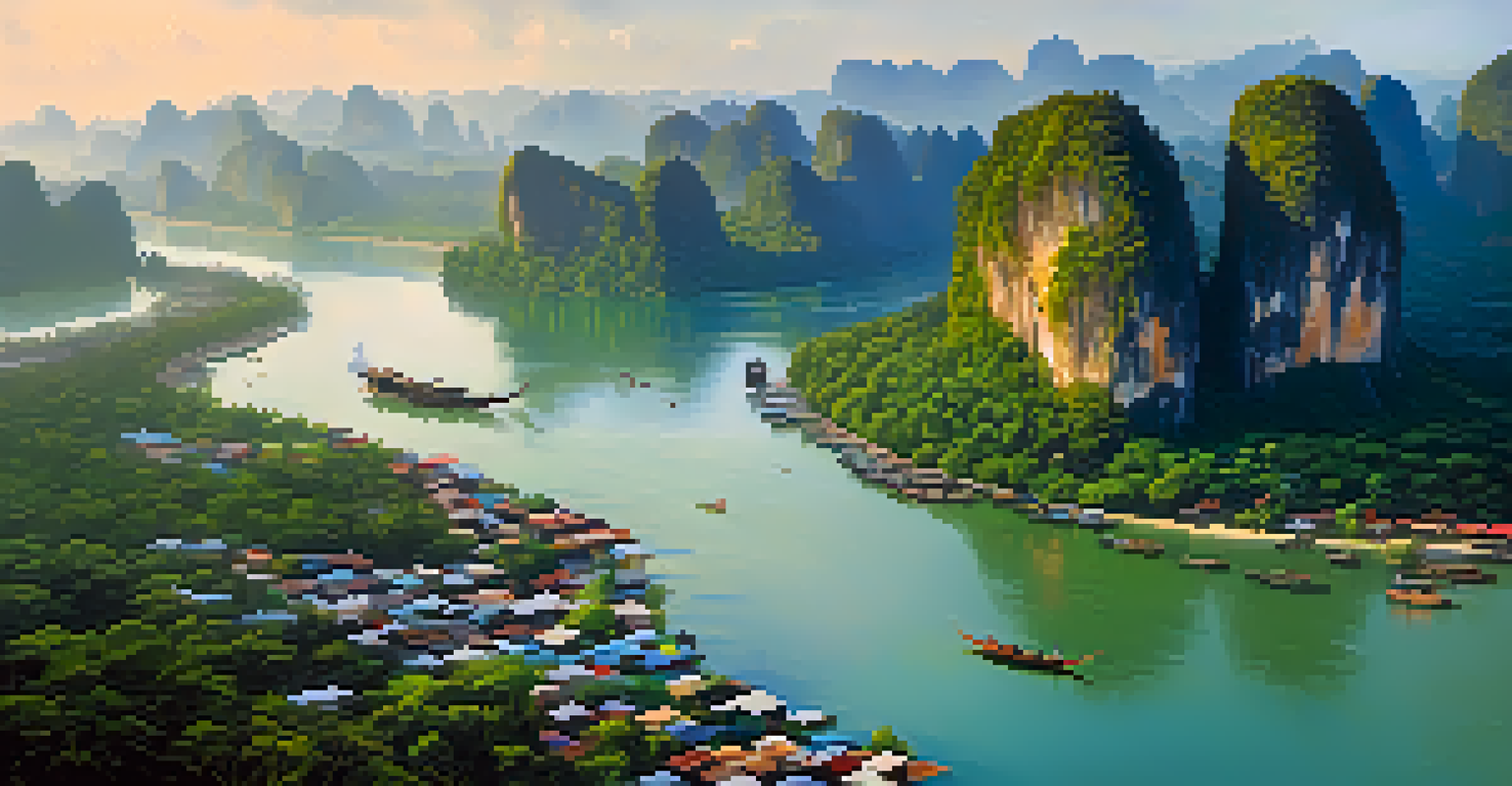Historic Krabi: A Guided Walking Tour Through Time

Introduction to Krabi's Historical Significance
Krabi, known for its stunning beaches, also boasts a rich history that dates back centuries. Nestled between the Andaman Sea and towering limestone cliffs, this region has been a melting pot of cultures. From ancient trade routes to colonial influences, Krabi's past is as captivating as its natural beauty.
History is not a burden on the memory but an illumination of the soul.
Walking through Krabi is like stepping into a living museum where each street and building tells a story. The blend of traditional Thai architecture and colonial remnants creates a unique atmosphere that invites exploration. Not only will you enjoy picturesque views, but you'll also uncover the tales of those who walked these paths long before us.
This guided walking tour promises to unveil the hidden gems of Krabi, from ancient temples to bustling markets, allowing you to connect with the local heritage. So lace up your walking shoes, and let's dive into the fascinating history of Krabi!
The Ancient Town of Krabi: A Glimpse into the Past
As you stroll through the ancient town of Krabi, you'll notice the charming mix of old and new. The architecture reflects a blend of traditional Thai styles and colonial influences, showcasing the area's evolution over time. Buildings adorned with vibrant murals and intricate carvings create a picturesque backdrop for your journey.

One must-see spot is the Krabi Town Walking Street, where local vendors sell handicrafts and delicious street food. This bustling market is not just a shopping destination; it’s a place where history meets daily life. Engaging with local artisans can provide insight into the traditions that have shaped Krabi's culture.
Krabi's Rich Cultural Heritage
Krabi's history is a vibrant tapestry of cultures, blending ancient traditions with colonial influences that can be experienced through its architecture and local markets.
While wandering the streets, keep an eye out for historical markers and plaques that offer fascinating tidbits about the town's past. Each step you take is a connection to the rich heritage that continues to thrive in Krabi today.
Discovering the Wat Tham Sua (Tiger Cave Temple)
No walking tour of Krabi would be complete without visiting Wat Tham Sua, or the Tiger Cave Temple. This iconic site is famous for its stunning views and spiritual significance. As you ascend the 1,237 steps to the summit, you’ll be greeted by breathtaking panoramas of the surrounding landscape.
The more you know about your history, the more liberated you are.
The temple itself is a fascinating blend of natural beauty and religious devotion, featuring intricate statues and peaceful meditation areas. Legend has it that this site was once home to tigers, and the remnants of their presence can still be felt. This adds an enchanting layer to your visit, as you explore the grounds.
Whether you’re interested in Buddhism, history, or simply stunning views, Wat Tham Sua offers a unique experience. Take your time to soak in the serene atmosphere and reflect on the spiritual journey that this temple represents.
Exploring Local Markets: A Taste of History
As we continue our walking tour, the local markets provide a vibrant snapshot of Krabi's culture. The Krabi Market, with its colorful stalls and lively atmosphere, showcases not only fresh produce but also traditional crafts. It’s a perfect place to sample local delicacies while immersing yourself in the daily life of Krabi’s residents.
Markets in Krabi have been gathering places for centuries, where locals exchange goods and stories. Engaging with vendors can offer personal insights into the history of their crafts and the significance of their products. Each item has a story, connecting you to the community and its heritage.
Significance of Local Markets
The local markets in Krabi not only offer delicious food but also serve as historical hubs where traditions and community stories are shared.
Don’t miss the chance to try local snacks, like grilled seafood and traditional desserts. These flavors are a delicious reminder of Krabi's rich culinary history, which reflects the influences of both Thai and international cuisines.
Heritage Sites: Temples and Historical Landmarks
Krabi is home to several heritage sites that reveal the region's historical depth. Temples like Wat Kaew Korawaram stand out with their striking architecture and serene surroundings. These sacred spaces invite visitors to explore both the artistic and spiritual aspects of Krabi's culture.
Each temple has its unique story, often dating back centuries, and serves as a testament to the local community’s faith and traditions. As you visit these sites, take a moment to appreciate the craftsmanship and dedication that went into their construction. They are not just places of worship but also historical landmarks.
Walking through these heritage sites allows you to connect with the past, understanding how these structures have shaped the identity of Krabi. They serve as a reminder of the enduring nature of culture and community.
The Role of Waterways in Krabi's History
Waterways have played a crucial role in Krabi's development, serving as transportation routes for trade and communication. The Krabi River, in particular, has been a lifeline for the local community, connecting the town to the sea and beyond. This historical significance is often overlooked but is essential to understanding the region's growth.
As you walk along the riverbanks, you can imagine the bustling activity that once took place. Boats laden with goods would have navigated these waters, bringing diverse influences into Krabi. Today, you can still see fishing boats and long-tail boats, a nod to the enduring relationship between the locals and their waterways.
The Role of Waterways
Waterways have been essential to Krabi's development, facilitating trade and connecting the community to its rich historical roots.
Exploring these rivers and canals adds another layer to your understanding of Krabi's history. They remind us of the importance of natural resources in shaping communities and the ongoing connection between people and their environment.
Concluding Your Journey Through Historic Krabi
As your walking tour of historic Krabi comes to a close, take a moment to reflect on the rich tapestry of stories and experiences you've encountered. From ancient temples to bustling markets, each stop along the way has contributed to a deeper understanding of this beautiful region. Krabi's history is not just in the past; it continues to influence the present.
Connecting with the local culture and history enhances your travel experience, making it more meaningful. By exploring Krabi on foot, you’ve not only seen the sights but also felt the heartbeat of the community. This personal connection is what travel is all about.

As you leave Krabi, carry these stories with you and share them with others. Whether it’s the delicious flavors, the stunning landscapes, or the rich history, Krabi will remain a cherished memory long after your visit.